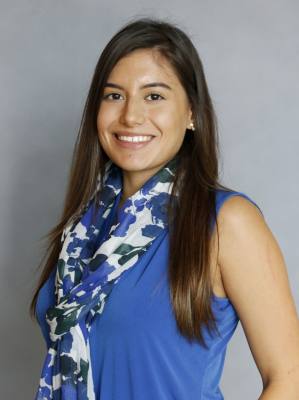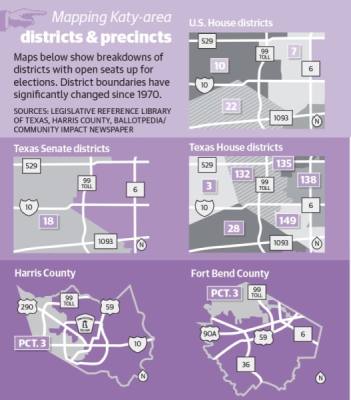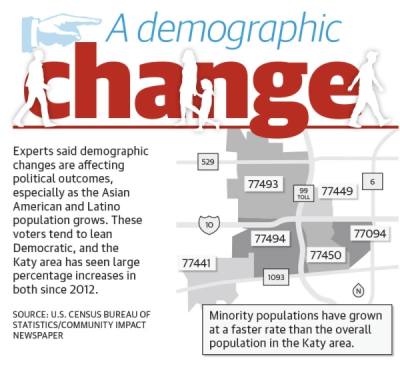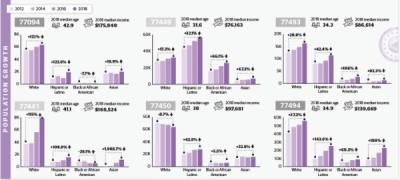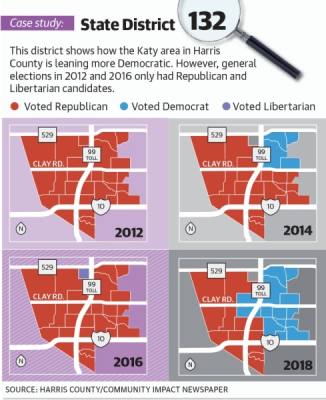“You’ve got a baker’s dozen of really critical races that will touch Katy in 2020,” said Brandon Rottinghaus, a political science professor at the University of Houston. “How Katy and western Houston votes in 2020 will tell us a lot about what is going to happen to Texas in the next decade.”
Some of these critical Katy-area races include seats in Fort Bend and Harris counties’ commissioners courts as well as Texas House District 28 and 132 and U.S. Senate districts 7, 10 and 22.
Experts said Democrats are now closer to winning the majority in some key elections in part because of demographic changes and the increase in Democratic candidates.
“Democrats have seen success, so they are going to want to build on that,” Rottinghaus said. “Republicans have seen some slumping, and they are going to want to get it back.”
Katy resident Keith Jobe said there has been an influx of people moving to the Katy area from predominantly Democratic states and voting to back Democratic ideals in Texas. Rory Robertson, whose family has lived in Katy since 1904, said he has also noticed this trend.
“The city of Katy is conservative and will remain conservative, but the surrounding area is at risk of a major blue shift because of the population growth,” Robertson said. “Texas is strong because we love our Texas values. We resist the values of California, Michigan, Illinois and others. We welcome all into our community, but just leave [out] the government overreach.”
Demographic changes
As more people move into Houston’s western suburbs, they are increasingly younger, nonwhite and more Democratic, said Robert Stein, a political expert at Rice University. They are also voting at higher rates.
“That is a very bad sign for Republicans,” Stein said. “[Young and more diverse voters] are replacing older white voters who are dying.”
The Katy area consists of six ZIP codes across Harris, Fort Bend and Waller counties: 77094, 77441, 77449, 77450, 77493, 77494. In six years, the median age in 77094 and 77441 decreased from 46 to 43 and 44 to 41, respectively, per U.S. Census Bureau data.
Rottinghaus said the demographics in Texas are increasingly younger and more ethnically diverse.
“Texas had a significant increase in the Latino vote and the youth vote in 2018,” he said. “Both of those constituencies are big parts of potential Democratic victories.”
The white population in 77450, which includes Cinco Ranch, decreased by an estimate of 400 individuals between 2012-18, according to census data.
In the same ZIP code, the Asian population increased by nearly 2,000 people, and the Hispanic and Latino population increased by over 5,000 over the same time period.
Stein said a lot of the growth experienced in the Katy area is due to in-migration, which is when people move to a region or community especially as part of a large-scale movement of population.
“Young people come to Texas to get jobs and graduate from college,” Stein said. “We also have in-migration from other countries. I’m not talking Mexico, Guatemala or Nicaragua. I’m talking South Asia, Pakistan, India, Taiwan [and] China.”
Local commercial broker Josie Lin, who is also an owner at Katy Asian Town, said she has noticed an influx of internationals as well as individuals from the east and west coasts move to the Katy area.
“There is a new chapter coming to Katy as multicultural residents move in,” Lin said. “I’m a minority, so I noticed the Asian population growth. That’s why we came up with the Katy Asian Town, to meet the multicultural demands.”
Fort Bend County Judge KP George, a Democrat, said this demographic shift is felt in his county.
Both he and Fort Bend County Precinct 4 Commissioner Ken DeMerchant unseated longtime Republicans on the court in 2018.
“With people from all walks of life, a wide berth of issues must be addressed at all levels—from municipal utility districts to school boards to Congress—because representation matters,” George said.
Political party shifts
In one decade, the Democratic-Republican share of votes in the Texas House of Representatives went from 100 Republicans and 50 Democrats in 2010 to only nine seats separating both parties in 2018, Stein said.
In 2010, over half of the races in the Texas House of Representatives did not have Democratic opponents for Republican incumbents, he said. In the 2020 primaries, every seat in the House has a Democrat competing.
“Texas—in places like Katy—will be the biggest battleground state as it is shifting toward more purple electoral outcomes,” Rottinghaus said. “Part of that is that you have a lot more Democratic candidates and higher Democratic turnout at the top and bottom of the ticket.”
Local turning points
Stein said the proof of this shift is in the results for the 2018 Fort Bend County elections, when Democrats won the district attorney’s office, obtained the majority on the Commissioners Court and nearly unseated Republican incumbent U.S. Rep. Pete Olson, who decided not to seek re-election in 2020.
This shift can also be seen in Texas House District 28, which covers northwest Fort Bend County, including Fulshear and Katy. The Republican incumbent, John Zerwas, was first elected in 2007 and resigned on Sept. 30.
State Democrats are eyeing Zerwas’ seat, in which he won re-election in 2018 by 8%, according to the Texas Tribune. Yet as recently as 2016, 2014 and 2012 general elections, no Democratic candidate ran against Zerwas.
Democrat Eliz Markowitz launched a bid for the seat in 2019 and received the highest number of votes in the November 2019 special election, but not enough to secure the seat. A runoff election between Markowitz and Republican Gary Gates is set for Jan. 28.
A similar shift from red to blue or purple can be seen in Harris County, too. Rottinghaus said the Harris County commissioners race will be a good indicator of whether there is enough support in the far western suburbs to support Democratic wins.
Republican Steve Radack will not seek a ninth term as Harris County Precinct 3 commissioner. His retirement is leaving the first open seat on the Harris County court since 2016, when Precinct 1 Commissioner El Franco Lee died. In the 2020 primaries, there are three Republicans and five Democrats who filed for the Precinct 3 race.
The seat for Texas House District 132, held by Democratic incumbent Gina Calanni, will also be a race for Harris County Katy-area residents to watch. She won the seat by about 100 votes against Republican incumbent Mike Schofield in the 2018 general state election. Both candidates have filed for the 2020 primaries along with Republican Angelica Garcia.
“Some of these politicians have proven to be effective and a success for their constituents, such as Gina Calanni,” Robertson said. “I disagree with most of her stances and with the Democrats in general, but she is out listening to the voters. The Republicans will need a strong candidate to unseat her.”
Becoming blue
Robertson said there is always a risk of a blue shift.
“In 2018, the [U.S.] Senate race proved that with an exciting candidate such as Beto O’Rourke against an incumbent such as Ted Cruz, one could be surprised,” Robertson said. “The percentages were close, it is still a huge number of votes to overcome for the Democrats to win a statewide race in the future.”
Robertson added ultimately the majority of voters in both parties are voting for the party as a whole and not for the person in each selected race.
“The problem with today’s voting is nobody will actually research the candidates,” Jobe said. “Just because someone claims a candidacy in the Democratic Party, it doesn’t necessarily mean I disagree with their platform and what they are doing. I don’t vote straight ticket.”
Jobe said he was uncertain about whether Texas will turn purple or blue in the next few years, but he still remembers when Texas voted Democrat—when the party was more conservative and neither party was very radical.
“Today, people on the left say it has to be their way, and people on the right say it has to be another way,” Jobe said. “No party seems to want to work with each other anymore. There are very few moderates these days, where you have your core beliefs on each side, but you are more flexible in order to get things done.”


